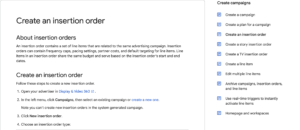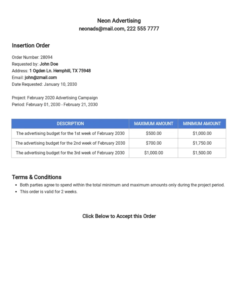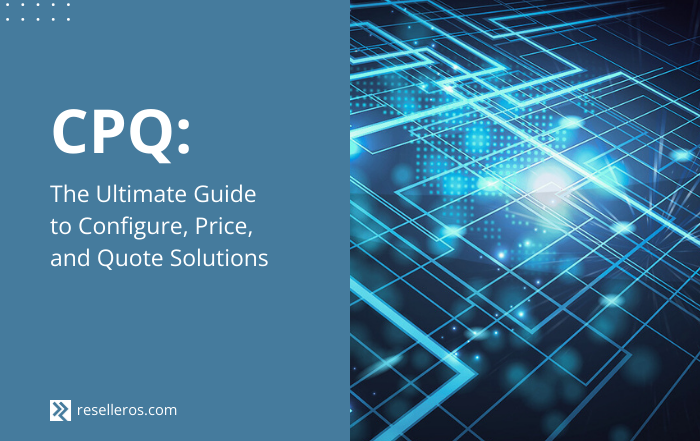Managing Media Insertion Orders
New technologies have dramatically changed the way publishers and advertisers do business over the last few decades. So much so that a marketer from 20 years ago dropped into the present day would hardly recognize the technical vocabulary of ad purchasing. Nevertheless, some legacy instruments of negotiation have remained in use such as media insertion orders.
Prior to the digital era, ad buys were almost exclusively transacted in contracts known as insertion orders. In 2022, 88.2% of digital display ad buys will take place in programmatic automated channels.
The remainder of these sales represent negotiated purchases where publishers and advertisers communicate directly to customize certain parameters. Insertion orders provide the legal record of these negotiations.
What is a Media Insertion Order?
An insertion order is a legal contract between publishers and advertisers. Insertion orders designate a publisher’s ad inventory for use by the purchasing advertiser. Prior to the age of programmatic buying, these negotiated agreements were part of nearly all ad purchases.
Additionally, publishers and advertisers use insertion orders to record the negotiated parameters of the purchase, which includes:
- Total ad budget
- Start and end dates
- Guaranteed impressions
- Target audience
- Price structure
- Design specifications
Programmatic ad buys generate these features automatically. Insertion orders allow publishers and advertisers to set them manually. As anything recorded in an insertion order is legally binding, the responsible parties should always review the details with caution.
The Pros and Cons of Insertion Orders
Whether or not insertion orders have a place in your business – either as a publisher or as an advertiser – depends on the scope of the purchases being negotiated and the relationships you have with your clients. In different contexts, the use of insertions orders will have different advantages and drawbacks.
Potential Benefits of Insertion Orders in Ad Purchasing
- Mitigate the Risk of Conflict: Because insertion orders require formal acknowledgement by both parties of all negotiated parameters, their use can minimize the risk of disagreements and conflicts in the execution of campaigns. Programmatic buys specify the details of purchases as well, but insertion orders add a layer of formalized assurance.
- Customize Campaigns: Insertion orders offer advertisers an opportunity to customize campaign features. An advertiser might specify though an insertion order that the same ads run in different formats at different times of a campaign to better serve target audiences or accommodate budget restrictions. Programmatic buying platforms generally don’t handle this level of customization.
- Build Personal Relationships with Clients: As a publisher, when you sell your inventory to an ad network, you remain essentially anonymous. Repeated transactions build no relationships. Negotiating directly gives you a chance to get to know your advertisers and develop mutually beneficial partnerships.
Potential Drawbacks of Insertion Orders in Ad Purchasing
- Publisher Preferences: With automated channels accounting for nearly 90% of digital ad buys, advertisers should expect fewer publishers to respond to direct overtures to negotiations. Publishers now have other options to move their remnant inventories such as private marketplaces. Private marketplaces create real-time auctions for remnant inventories extended to advertisers on an invitational basis.
- Obsolescence in Most Purchasing Contexts: When publishers and advertisers can strike mutually beneficial deals through automated channels, insertion orders add nothing to the equation. They represent the manual option in a system of rapidly evolving automation. In most contemporary contexts, it’s safe to say that if insertion orders didn’t exist, you probably wouldn’t invent them.
- Slower and More Labor-Intensive Purchase Processing: For the same reasons that insertion orders can provide enhanced customization and clarity between publishers and advertisers, they also require more time and labor to negotiate. Unless the particulars of the deal compensate these inefficiencies – an often challenging calculation without consultation – negotiation through insertion orders is not likely to be superior at the bottom line.
Modernizing Insertion Orders
A few options exist to reduce the added labor in creating insertion orders. Ideally any business looking to take advantage of directly negotiated ad deals should attempt to streamline the process as much as possible.
Insertion Order Templates
To get you started, both Google and Bing offer highly functional standardized templates for insertion orders. These contain the common line items including:
- Frequency caps
- Pacing settings
- Partner costs
- Default targeting
Alternatively, you could use paid services or inhouse design to create custom insertion order forms. In either case you want to minimize the number of times you have to write an order form from scratch.
Automated Insertion Order Management
Even with templates, the use of insertion orders involves some task repetition, the cost of which accumulates over time. Software that integrates workflow tools with generating insertion orders can add another level of process automation in marketing.
With the right software, publishers and advertisers can generate insertion orders for multiple clients that share imported line items, pricing, and dynamic calculation, eliminating hours of tedious manual input.
Insertion orders often linger in legal and compliance departments. Integrating your order creation with a database of pre-approved legal terms and conditions can accelerate their approval.
As insertion orders are legal contracts, they require signatures. Setting up your system to accommodate a variety of e-signature applications such as Acrobat Sign and DocuSign will greatly improve its overall efficiency.
Keep Pace with Technological Change and Minimize Your Total Cost of Ownership
The rapid pace of change in how businesses perform fundamental transactions such as the buying and selling of ad spaces can challenge even experienced professionals. Knowing when to follow trends and integrate new technologies and when to buck the norm for the sake of personalized client relationships requires both experience and insight.
At Rainmaker, our team of experts brings years of experience and a proven track record of success to the table.
To explore the power of leveraging deep technical expertise with engaged consulting, contact Rainmaker today.








